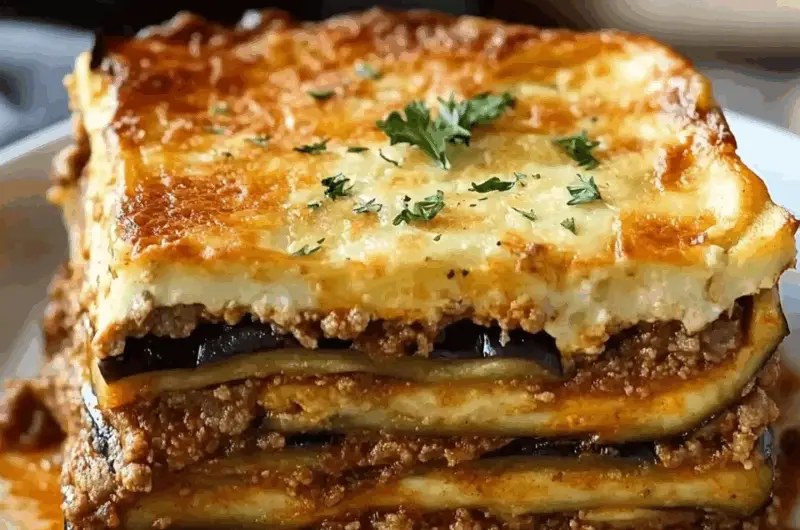The Role of Eggplant in Moussaka
Eggplant is the star vegetable in this dish, providing both texture and flavor. The slices are salted before roasting to draw out excess moisture and bitterness, ensuring a tender, melt-in-your-mouth texture once cooked. Roasting the eggplant after salting gives it a beautifully caramelized surface that enhances its natural sweetness while softening the flesh. This method prevents sogginess in the final casserole, allowing the eggplant to hold its shape between the layers and absorb the savory juices of the meat sauce. Olive oil, a staple in Mediterranean cooking, adds richness and depth during roasting.
Crafting the Perfect Meat Sauce
The meat sauce in moussaka is deeply aromatic and spiced to perfection. Ground beef or lamb serves as the base, offering a rich and hearty flavor. Lamb is traditional in Greek cuisine and provides a gamey depth, but beef is a popular substitute for a milder taste. The meat is browned to develop flavor, then combined with sautéed onions and garlic, which add sweetness and pungency. The sauce is enhanced with canned diced tomatoes, oregano, and cinnamon. The oregano adds a classic Mediterranean herbaceous note, while cinnamon lends a warm, slightly sweet complexity that is characteristic of Greek cooking. The sauce is simmered until thickened, creating a robust, flavorful layer that contrasts beautifully with the tender eggplant.
The Creamy Béchamel: The Luxurious Finish
A hallmark of Greek moussaka is the béchamel sauce topping. This creamy white sauce brings richness and a velvety texture that contrasts with the savory meat and roasted vegetables below. Traditionally made with butter, flour, warm milk, eggs, and nutmeg, béchamel is cooked gently until thickened. The eggs are tempered carefully into the sauce, adding body and a custard-like firmness when baked. Nutmeg adds a subtle warmth and fragrant note that lifts the sauce’s flavor. This béchamel layer is spread generously over the assembled casserole, creating a golden, bubbly crust after baking that adds both visual appeal and indulgence.
Assembly and Baking: Bringing It All Together
The assembly of moussaka is a careful layering process. Half of the roasted eggplant slices form the base layer in the baking dish, followed by the entire meat sauce spread evenly on top. The remaining eggplant slices are layered above the meat, and the dish is finished with the creamy béchamel sauce. This layering creates a balance of textures and flavors in every bite — the softness of the eggplant, the rich meatiness of the sauce, and the smooth, creamy topping. Baking at a moderate temperature allows the casserole to cook through gently, melding the layers together while developing a golden, slightly crisp top. Allowing the moussaka to rest after baking is crucial, as it helps the layers to set, making it easier to slice and serve.
Nutritional Considerations
Moussaka offers a balanced mix of macronutrients, with a satisfying combination of protein, carbohydrates, and fats. The protein content primarily comes from the ground meat, essential for muscle repair and overall body function. The fat content, including saturated fats from butter and meat, contributes to the dish’s rich flavor and creamy texture but should be consumed mindfully as part of a balanced diet. The carbohydrates come mainly from the eggplant and the béchamel’s flour and milk components. Fiber from the eggplant supports digestion, while sodium levels depend on seasoning and added salt. Portion control is important since this is a calorie-dense dish, but its nutrient-rich profile makes it a wholesome option for a comforting meal.
Cultural and Culinary Significance
Moussaka holds a treasured place in Greek culinary heritage and is often served during family gatherings, celebrations, and holidays. It reflects the Mediterranean diet’s emphasis on fresh vegetables, quality meats, and healthy fats like olive oil. The use of cinnamon and nutmeg showcases the region’s unique spice influences that differentiate Greek cooking from other Mediterranean cuisines. This casserole is a symbol of hospitality and tradition, passed down through generations, bringing warmth and satisfaction to the table.
Serving Suggestions
Classic Greek Eggplant Moussaka is often enjoyed with simple accompaniments that complement its richness. A fresh Greek salad featuring tomatoes, cucumbers, olives, and feta cheese adds a bright, acidic contrast. Crusty bread or pita can be served alongside to soak up any leftover sauce. For a traditional Greek meal, pair the moussaka with a glass of robust red wine or a refreshing white, balancing the dish’s richness. Leftovers, if any, reheat well and often taste even better after the flavors meld overnight.
Conclusion
Classic Greek Eggplant Moussaka is a timeless Mediterranean dish that offers a satisfying blend of roasted vegetables, spiced meat sauce, and creamy béchamel. Its layers of texture and flavor create a comforting yet elegant meal that has earned its place as a family favorite across Greece and beyond. The balance of savory and aromatic elements, along with the luxurious sauce, makes this casserole a perfect centerpiece for any gathering or cozy dinner. With its rich heritage and satisfying taste, moussaka continues to be a delicious testament to the beauty of traditional Mediterranean cooking.








